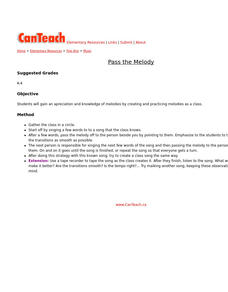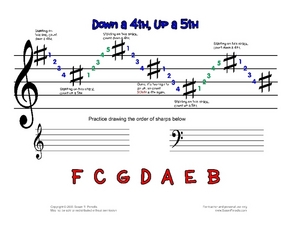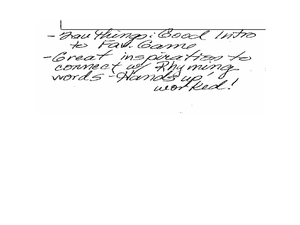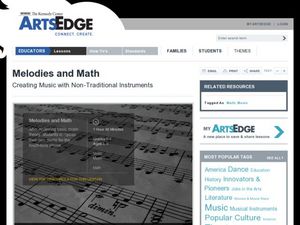Fun Music Company
Transposition
Up a perfect fifth, down an octave. Transposing a piece to suit the range of singers, and instrumentalists, is a key skill musicians must perfect. This worksheet explains how to transpose and gives learners a change to practice.
Fun Music Company
Working Out the Key
"Gimme an E minor!" Or any key for that matter. But how do you figure out the key of a piece of music? Here's a worksheet that shows young musicians three easy steps to help them identify the key of a piece of music.
Fun Music Company
Classification of Intervals
Major 2nd, Perfect 4th, Minor 3rd. The number and classification of intervals are the focus of a one-page worksheet that asks musicians to write the intervals above given notes and to indicate the classification of others.
Fun Music Company
Relative Major and Minor
It's all relative. Young music theorists are asked to count to three and identify the relative major and minor keys of keys that share the same signature.
Fun Music Company
Musical Terms for the Digital Age
Young musicians must unscramble music expressions and then use the key pad from a digital keyboard to answer a music trivia question.
Fun Music Company
Writing Major Scales
Designed as an assessment of understanding, this one-page worksheet asks musicians to demonstrate their understanding of scales by drawing C, G, and F Major scales on the provided staffs.
Fun Music Company
The Bass Clef
Every Good Boy, and girl for that matter, will do just fine with this activity as they are asked to correctly trace and then draw bass clefs on the provided activity.
Fun Music Company
The Treble Clef
Gee, your young musicians should have no trouble tracing the treble clefs on this worksheet. Once they have mastered this tricky signature, they place it correctly on a staff.
Fun Music Company
The C Major Scale
Your young musicians will take note of this worksheet that asks them to mark the half steps in a C major scale and then write the scale in both treble and bass clef.
Fun Music Company
Keys and Circle of Fifths
How sharp are your young musicians? Can they perfectly identify the sharps and flats in each key by completing a circle of fifths diagram? There is solid theory behind this exercise.
WHB Elementary School Band
Circle of Fifths: Major Keys
How many sharps and flats are their in each of the major keys? Help keep your young musicians sharp with a printable template that models how to identify the signature for the major keys' sharps and flats.
Can Teach
Pass the Melody
Get a jam session started in your elementary music class! Learners engage in melody transitions by singing a familiar song and passing on the tune to the next person.
Curated OER
Parallel Harmonies
What is a parallel harmony? You and your class can explore musical terminology through song. You define what a parallel harmony is, the class identifies parallel harmony in music they hear, and then you all sing some examples together....
Curated OER
Missing the Major Scales 2
Any musician can tell you, you have to know your scales, key signatures, and notes when reading sheet music. Kids are quizzed on major scales and the notes found with in each scale. They fill in the missing notes and identify each scale.
Curated OER
Independent Harmonies
Independent harmonies, homophonic music, intervals, and melody are all part of music theory and practice. Prepare your budding musicians for the big time with these activities focused on playing with accompaniment. This instructional...
Curated OER
A Musical Composition Experience
Upper graders having skills in music performance will extend their abilities through creative musical composition. They'll use Finale 2000 to explore facets of music composition, they'll then compose a piece for their instrument in C, F,...
Curated OER
Down a 4th, Up a 5th
It's time to practice those sharps. Young musicians write the order of sharps by counting down a fourth and up a fifth. This is a great way to teach sharps to emergent musical note readers.
Special needs in Music
Silent Practice
Don't have a keyboard in the classroom but still want to teach piano theory? No problem! Learners engage in "silent practice" as they play classic songs like "My Country 'Tis of Thee" on a printed keyboard image. Use the images on the...
Curated OER
Keys and Scales are Sets
Music theory lessons can be very tricky for some people. Children with a basic understanding of musical concepts take on the task of transposing music and identifying scale sets. This would be a good topic to address prior to discussing...
Curated OER
A Pentatonic Scale Activity
The famous Japanese tune, "Cherry Blooms" was composed using a pentatonic scale. Budding musicians explore the nature and theory behind the pentatonic scale as well as the East Asian music it is commonly used in. Multiple extensions are...
Curated OER
Classroom Builder
Students explore music theory by discussing a classic song. In this musical notation instructional activity, students listen to the song "My Favorite Things" and discuss and share their personal tastes with the class. Students practice...
Curated OER
Melodies and Math: Creating Music with Non-Traditional Instruments
Review the 4/4 and 2/4 time signatures in music with a helpful music theory lesson plan. Young musicians experiment with electronic sounds and create their own musical performance using instruments made from materials found in the...
Curated OER
Not Your Grandma's Music: A Lesson in Music History
Students experience and discuss the different musical periods such as Baroque, Classical and Romantic. In this music lesson, students discover musical theory and apply it to the Baroque, Classical, and Romantic periods. Students will...
MakingMusicFun.net
Let's Crossword | Music Theory Worksheet - Bass Clef Note Names (Digital Print)
In this music notes activity, students recognize music notes in the bass clef. Students complete the activity by determining the notes for the nine sets and filling in the crossword puzzle.

























